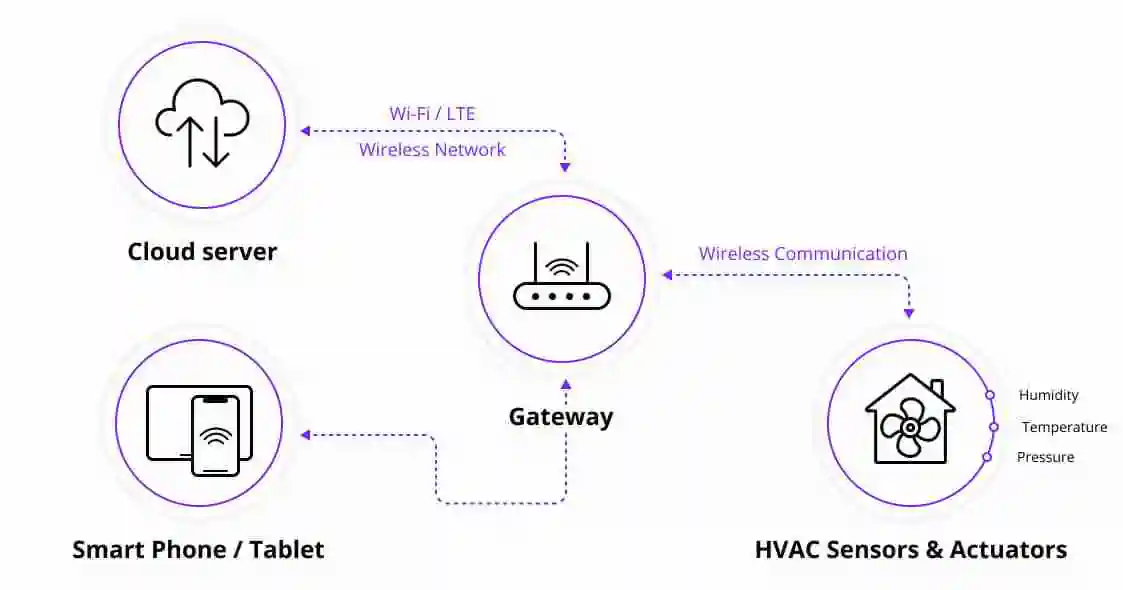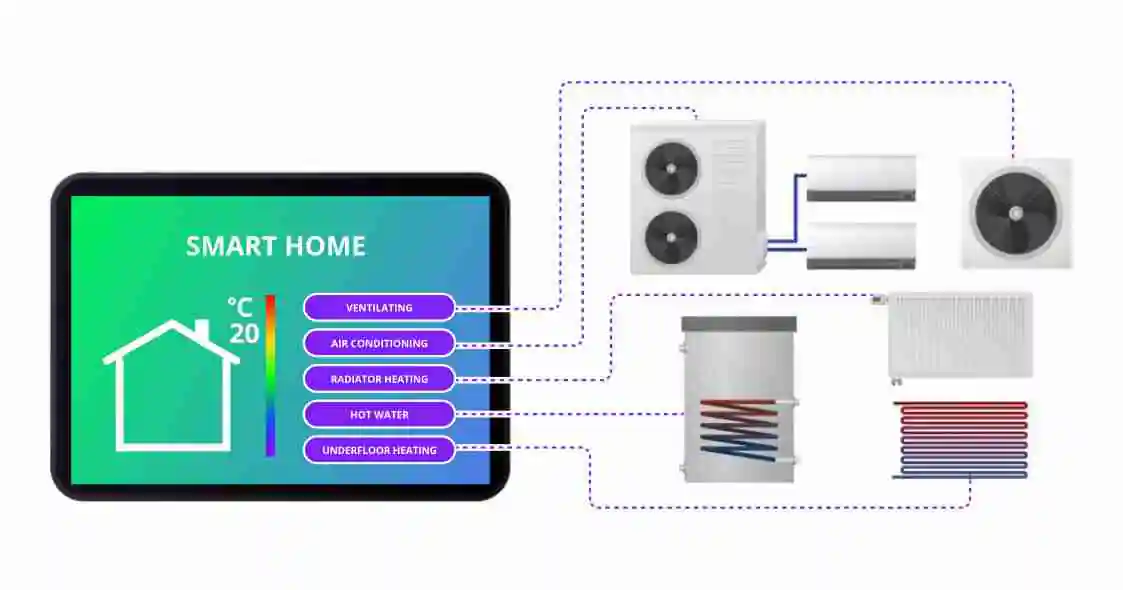Smart HVAC
Originating in the early 20th century, the heat, ventilation, and air conditioning (HVAC) industry revolutionized the way we construct buildings. With smart HVAC systems, it became possible to heat the buildings during the wintertime without fire in the fireplace or stove that burned fuel. The necessity of cooling buildings during the sweltering season was fulfilled with the invention of air conditioning. At the same time, the introduction of HVAC systems brought new challenges for architects. One of them is to make buildings energy-efficient.
According to the study performed by the Sustainable Buildings Industry Council, commercial and residential buildings consume approximately 72% and 41% of electricity produced in the U.S. In 2009, American buildings used 48% more resources than in 1980. A great share of the consumption account for the smart HVAC system. Because of global warming, as well as the rising price for energy sources, such large consumption of energy is wasteful; therefore optimization is required. A revolutionizing technology of the fourth industrial revolution that may help optimize personal HVAC systems is the IoT. It saves costs, grants a better user experience, and facilitates the maintenance of the HVAC system.
Ways IoT is transforming HVAC or smart heating and cooling
Internet of Things (or simply IoT) is the network of devices connected with each other through the internet. In the consumers market, IoT software solutions are most commonly used for home automation. The IoT technology stack allows you to remotely control any device you use in your everyday life, whether it is a lamp or a heater. The combination of devices with automated systems helps to gather information, process it, and create an action. Collected data helps devices learn and perform better in the future.
Devices inside the network may be connected with wires or wireless. Although cable connection is more reliable, wireless solutions are more mobile and easier to deploy. No additional constructional works are required. There are four main types of IoT wireless networks: cellular, LAN/PAN, LPWAN, and mesh protocols. The device inside the network may communicate directly or through a hab. To make controlling the IoT network more convenient you might also plug in a clever assistant, like Amazon Alexa or Siri.
Smart HVAC systems
Although the elements of HVAC have existed since the early 1900s, it wasn’t until the 1980s when the American Society of Heating, Refrigerating, and Air-Conditioning Engineers set the minimum requirements for the energy efficiency of architecture designs. Those requirements reference such areas of construction as wall and ceiling isolation, window and door placement, lighting fixtures, and HVAC equipment productivity. Standard 90.1 is considered to be a major milestone in HVAC history since it motivated engineers to think about the reduction of energy consumption.
During the same period, energy management received recognition as a separate discipline, and new technology, – Building Energy Management Systems (BEMS) emerged. Early systems applied mini-computers for the automation of HVAC control. Although those systems were expensive and their efficiency was much lower than advertised, BEMS paved the road for modern smart HVAC systems.
Components of a smart HVAC system

What happens when HVAC and the IoT join forces
The current advancement of electronics makes it possible to plug almost any machinery into the Web and HVAC is not an exclusion. The internet connection grants remote control over such vital climate indicators as temperature and humidity. With smart HVAC, you may adjust the setting of the heating, conditioning, and ventilation by yourself or with the help of AI.
A typical smart HVAC equipment includes:
Sensors that collect the data. In HVAC, it is usually a smart thermostat. Motion sensors may be used as well since they help adjust the HVAC setting according to the room occupancy.
A hub that receives, stores, and analyses the information. As a rule, the data are processed by the cloud server although a local computer may also be used.
Controllers that regulate the HVAC activity. A remote controller may be installed on almost any smart HVAC system: compressors, air handlers, heating, and cooling devices
A smartphone or tablet to access the HVAC system.
HVAC applications that enable user control over the system.
Why you should adopt smart HVAC
The demand for HVAC devices increased during the last year. In 2018, more than 500 thousand customers from Great Britain installed smart thermostats in their homes. In 2020, the year increase of new thermostat users reached 1 million. The data provided by Statista shows that 8 of 10 smart HVAC users are satisfied with the user experience and would buy another such device in the future. More and more consumers stick with the HVAC IoT for the following reasons:
- To reduce spending on heating, cooling, and ventilation – By adjusting the temperature settings according to the current occupancy of the building in real-time, weather conditions, and level of CO2, smart HVAC reduces wasteful spending of energy. The system consumes just enough resources as is needed and nothing more. A study from 2019 proves that a smart HVAC control performs better by 57% than a manual On-Off and PID control strategy. Real-time monitoring of system performance helps identify elements that use the majority of energy. By knowing which of the HVAC units consumes most of the resources, you may consider replacing it with a more economic alternative.
- Optimization of the energy system workload – It is no secret that energy consumption differs throughout the day. During working hours, cities use more electricity than during leisure time. At the same time, the production of energy is hard to adjust. The electric stations produce the same amount of electricity during the whole day. For this reason, it appears that at night stations work at idle. The smart controllers allow setting specific hours when the IoT HVAC monitoring system is working. Switching on the HVAC during the night and turning it off during the day will help to avoid overloads
- Better comfort for the user – Modern ventilation and heating devices are highly customizable. You may set the temperature, fan speed, and rhythm, humidity, etc. Preset working modes are also available. Some of the top-class devices have more than 20 regimes! Also having complete control over the HVAC system is a benefit, the great variability of setting brings the struggle of choice. With the smart HVAC, you may delegate the decision to the computer. The combination of smart HVAC with machine learning helps the system to learn and adapt to user preferences in advance. Some studies show that AI-enabled HVAC systems improve the customer experience from 75% to 95%.
- In-time maintenance alerts -Regular repair of the HVAC system is as important for cost savings as the decrease of consumption. Smart sensors constantly monitor the integrity of the HVAC infrastructure and send alerts when maintenance is required. Some applications even go further and may book the repair services automatically. Complete information about the elements requiring attention is provided. As specialists arrive they already own the essential diagnostic data to solve the problem. In case of an emergency, like the water or gas leak the application shots the whole system down.
Main features of a smart HVAC system

Address challenges of using IoT in HVAC
Don’t neglect the security
The first and the most significant risks of implementing IoT in HVAC are cyber-security concerns. Everything that is connected to the internet may be hacked. With the help of modern technologies, malefactors may scan the entire internet in an hour and target any device whether it is a toaster or a strongly protected server. An experiment held by Andrew McGill, senior product manager at The Atlantic, showed that an average IoT device is being attacked more than 300 times per 11 hours! Many of the hackers use the default passwords set by the device producer. Although companies are spending huge budgets on cyber-security (in 2020, the global spendings reached $120 000 million), their networks are still vulnerable. A tiny slit in the security is enough for the malefactors to enter the network and cause financial and reputational damage. The stories of hackers compromising sensitive data with the help of IoT devices frequently appear in the media. An interesting case happened in 2017. An American casino installed a new fish tank for the attraction of visitors equipped with high-tech sensors that regulated salinity, temperature, and feeding schedule. To isolate the tank from the rest of the casino’s network, the administration configured the device to use an individual VPN. Nevertheless, a later security check identified some anomalous data transfer from the fish tank. A total of 10 GB of data were sent to the external location somewhere in Finland.
Make sure that devices are compatible
The other challenge a user may face while installing IoT infrastructure is the bad compatibility of the elements. Individually good working, the smart devices may malfunction when connected to one network. That usually happens due to different communication protocols, like ZigBee, Z-Wave, Wi-Fi, or Bluetooth used by gadgets. The producing company may also add extra restrictions towards devices made by their competitors. For this reason, prior to buying a new accessory, it is worth double-checking if it is compatible with your current IoT system.
Install interusabile applications
Interusability is related to compatibility but identifies the similarity in user experience rather than device compatibility. The need to learn new ways of interaction with the system builds the same acceptance barrier as technical non-compliance of electronics. In smart HVAC systems, different menu elements, design patterns or terminology between applications may harm interusability. Sometimes, apps can display contradictory system states because they query the status at different time periods. To get the best user experience, install applications from the same developer.
Avoid latency
Sometimes, different IoT devices may work asynchronously. Some commands are executed with delays which interrupts the user experience. This happens due to the latency time required for the transmission and processing of the data. The connection between devices may also be disturbed. It happens both with wireless and wired connections, although the latter is considered to be more reliable. To improve the quality of the internet connection, enhance your signals and make sure that major barriers, like sick walls, don’t shut the signal line.
Install sensors in the right places
Another part of designing smart HVAC systems is to install the sensors in the right place. The temperature and the humidity inside the same room may differ due to the different activities happening in the building. For example, a thermostat installed over the oven will indicate a higher temperature of the air than it is in reality. Proper planning of the disposition of the sensor requires special knowledge and experience. It is better to consult with experienced IoT and HVAC engineers prior to installing HVAC devices.
Hire trained specialist
Since smart HVAC is a novelty, there is a shortage of engineers who know how to design, install, and maintain the IoT infrastructure. A good specialist needs to know how the HVAC works as well as be familiar with IoT and cloud computing. Since the smart HVAC industry is fast-growing and new products appear frequently, regular training is also necessary. Partnering with companies with strong IoT expertise can help you gain a competitive advantage in your HVAC endeavors.
How much does HVAC software cost?
HVAC system aims at creating a comfortable thermal environment in the building. It can be either cooling down or warming up, as well as purifying the air. The pricing varies depending on the functionality of the system and its components. It is not only about installing cheaper or more expensive components but also their quantity.
To select the software that can maintain the functioning of the system, all the components have to be analyzed and assessed. The software developers bring together the existing elements of HVAC and look into ways to make them use less energy. Besides, they ensure that maintenance of such a system happens timely. In general, the price of design will be influenced by many factors. In any case, such payment is considered to be an investment that will pay off within the next years of your HVAC operation.
How to calculate the price of your HVAC software?
Estimation of a price happens at the stage of discovery. At this point, the team of developers analyses the idea. Based on the client’s requirements, wishes, and concept the functionality set is developed and approved. In case there is existing equipment, and the new one is not considered, a thorough analysis of element compatibility is conducted. With our team, you get a quick and reliable feature-based cost estimate and potential improvements to the existing system. The criteria that our team uses for pricing include:
- Design. The idea might be as simple or complex as you wish. Depending on the purpose of the software, the size of the building, and the prerequisites given by the client, the developers find the optimal solution. All the existing equipment pieces have to be compatible or made compatible. It will influence the time spent on the design.
- Project and building size. HVAC systems in residential buildings differ from industrial ones. In addition, residential buildings of different types have specific needs when it comes to air conditioning. One of the vital aspects is zoning. It enables control over temperatures in separate areas or zones. With proper zoning, energy efficiency increases. The software helps to collect data on all zones and prevents the excessive use of resources. The larger building needs the system, the more work goes into making sure that all elements are compatible and easily accessible for the operator. Project size can be small, medium, or large. To define the scale of the project, the developers count the number of sensors and controllers needed, as well as the data that has to be stored and manipulated.
- Feature set. HVAC systems are used not only in the smart house or office sector. Some clients provide services of installing the equipment and maintaining it. For those, it will be important to add customer management features to the software.
- Platform. The choice of a platform influences pricing greatly. Is it convenient for you to use a mobile application? If so, do you need it for iOS or Android, or maybe both? Some may consider a web application as a more suitable solution. Besides, the price of an IoT system built from scratch will differ from the modernization of the existing one.
- Complexity. A project is complex when it requires third-party integrations, the development of multiple platforms, and sophisticated security.
- Development. A predecessor of the development process is the discovery stage. It envisages a detailed discussion of the client’s vision, requirements, wishes, and costs. Through a series of workshops, the Euristiq team can identify the desired feature set, assess the deadlines, and provide a turnkey solution. Since customization has no limits, the update and integration of the existing systems are also possible.
Conclusion
Although IoT is a relatively new technology, it has already transformed the HVAC industry. In 2021, it is a standard to install smart HVAC systems into buildings. The growing demand for IoT HVAC is indicated by the growth of smart thermostat shipments. Between 2018 and 2022, the global shipments of those devices are expected to grow by 29% and reach $37.5 million. Wide adaptation of smart HVAC systems will soon change the way companies set pricing for electricity. Currently, the majority of electricity providers have fixed prices that don’t change regardless of the demand which fluctuates during the day. The wide introduction of the IoT will enable “time-of-use pricing” meaning that households will purchase energy through the supply and demand mechanism.
By optimizing energy consumption, smart HVAC makes our facilities more sustainable. Nevertheless, automation of HVAC is only the first step of the green transformation of our buildings. Solar-powered HVAC may be another solution. If you are ready to tap into the possibilities that smart HVAC systems have to offer, contact us. We’d be happy to consult and help you with IoT-powered HVAC solutions.







